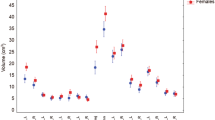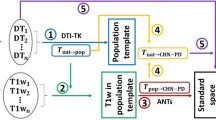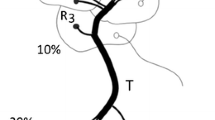Abstract
Purpose
The aim of this study is to study the age, gender and lateral asymmetry-related white matter changes of long association tracts throughout late childhood and adolescence into adulthood using diffusion tensor tractography (DTT).
Methods
DTT was performed in 44 healthy subjects aged 7–45 years. Fractional anisotropy (FA), radial diffusivity (RD), axial diffusivity (AD), Trace, density and volume were calculated for long association tracts, namely the inferior fronto-occipital fasciculus (IFOF), inferior longitudinal fasciculus (ILF), uncinate fasciculus, superior longitudinal fasciculus (SLF) and its arcuate fibres. FA and diffusivity indices were correlated as function of age using Pearson correlation test. Comparison between males and females, and comparison between both hemispheres among all participants were also performed. A p value less than .01 was considered significant.
Results
The majority of the examined tracts (SLF and IFOF of both hemispheres, and the arcuate fasciculus, uncinate fasciculus, and ILF of the left hemisphere) followed a common pattern of metric changes with age. This pattern was characterized by significant FA increase accompanied by reduction in RD, Trace without significant AD changes. The right arcuate fasciculus showed similar pattern but without significant FA changes. The right uncinate and right ILF fasciculus demonstrated significant reduction in RD, Trace and AD, with and without significant FA increase, respectively. Left hemispheric dominance regarding the FA and diffusivity indices was demonstrated in uncinate fasciculus with no significant gender-related differences.
Conclusion
Significant microstructural tract-specific maturation processes continue throughout late childhood into adulthood. These processes may represent stages in a cascade of age-related maturation in white matter microstructure.


Similar content being viewed by others
References
Lebel C, Gee M, Camicioli R et al (2012) Diffusion tensor imaging of white matter tract evolution over the lifespan. NeuroImage 60:340–352
Jellison BJ, Field AS, Medow J et al (2004) Diffusion tensor imaging of cerebral white matter: a pictorial review of physics, fiber tract anatomy, and tumor imaging patterns. Am J Neuroradiol 25:356–369
Casey BJ, Tottenham N, Liston C et al (2005) Imaging the developing brain: what have we learned about cognitive development? Trends Cogn Sci 9:104–110
Grossman AW, Churchill JD, McKinney BC et al (2003) Experience effects on brain development: possible contributions to psychopathology. J Child Psychol Psychiatry 44:33–63
Wolff JJ, Gu H, Gerig G et al (2012) Differences in white matter fiber tract development present from 6 to 24 months in infants with autism. Am J Psychiatry 169:589–600
Meng JZ, Guo LW, Cheng H et al (2012) Correlation between cognitive function and the association fibers in patients with Alzheimer’s disease using diffusion tensor imaging. J Clin Neurosci 19(12):1659–1663
Giorgio A, Watkins KE, Douaud G et al (2008) Changes in white matter microstructure during adolescence. NeuroImage 39:52–61
Qiu D, Tan LH, Zhou K et al (2008) Diffusion tensor imaging of normal white matter maturation from late childhood to young adulthood: voxel-wise evaluation of mean diffusivity, fractional anisotropy, radial and axial diffusivities, and correlation with reading development. NeuroImage 41:223–232
Snook L, Plewes C, Beaulieu C (2007) Voxel based versus region of interest analysis in diffusion tensor imaging of neurodevelopment. NeuroImage 34:243–252
Muzik O, Chugani DC, Juhasz C et al (2000) Statistical parametric mapping: assessment of application in children. NeuroImage 12:538–549
Jones DK, Symms MR, Cercignani M et al (2005) The effect of filter size on VBM analyses of DT-MRI data. NeuroImage 26:546–554
Mori S, Kaufmann WE, Davatzikos C et al (2002) Imaging cortical association tracts in the human brain using diffusion-tensor-based axonal tracking. Magn Reson Med 47:215–223
Catani M, Howard RJ, Pajevic S et al (2002) Virtual in vivo interactive dissection of white matter fasciculi in the human brain. NeuroImage 17:77–94
Wakana S, Caprihan A, Panzenboeck MM et al (2007) Reproducibility of quantitative tractography methods applied to cerebral white matter. NeuroImage 36:630–644
Berman JI, Mukherjee P, Partridge SC et al (2005) Quantitative diffusion tensor MRI fiber tractography of sensorimotor white matter development in premature infants. NeuroImage 27:862–871
Dubois J, Hertz-Pannier L, Dehaene-Lambertz G et al (2006) Assessment of the early organization and maturation of infants’ cerebral white matter fiber bundles: a feasibility study using quantitative diffusion tensor imaging and tractography. NeuroImage 30:1121–1132
Zacharia A, Zimine S, Lovblad KO (2006) Early assessment of brain maturation by MR imaging segmentation in neonates and premature infants. Am J Neuroradiol 27:972–977
Giménez M, Miranda MJ, Born AP et al (2008) Accelerated cerebral white matter development in preterm infants: a voxel-based morphometry study with diffusion tensor MR imaging. NeuroImage 41:728–734
Moon WJ, Provenzale JM, Sarikaya B et al (2011) Diffusion-tensor imaging assessment of white matter maturation in childhood and adolescence. Am J Roentgenol 197:704–712
Schmithorst VJ, Wilke M, Dardzinski BJ et al (2002) Correlation of white matter diffusivity and anisotropy with age during childhood and adolescence: a cross-sectional diffusion-tensor MR imaging study. Radiology 222:212–218
Barnea-Goraly N, Menon V, Eckert M et al (2005) White matter development during childhood and adolescence: a cross-sectional diffusion tensor imaging study. Cereb Cortex 15:1848–1854
Eluvathingal TJ, Hasan KM, Kramer L et al (2007) Quantitative diffusion tensor tractography of association and projection fibers in normally developing children and adolescents. Cereb Cortex 17:2760–2768
Snook L, Paulson LA, Roy D et al (2005) Diffusion tensor imaging of neurodevelopment in children and young adults. NeuroImage 26:1164–1173
Lebel C, Walker L, Leemans A et al (2008) Microstructural maturation of the human brain from childhood to adulthood. NeuroImage 40:1044–1055
Asato MR, Terwilliger R, Woo J et al (2010) White matter development in adolescence: a DTI study. Cereb Cortex 20:2122–2131
Lebel C, Beaulieu C (2011) Longitudinal development of human brain wiring continues from childhood into adulthood. J Neurosci 31:10937–10947
Kumar R, Nguyen HD, Macey PM et al (2012) Regional brain axial and radial diffusivity changes during development. J Neurosci Res 90:346–355
Hasan KM, Kamali A, Abid H et al (2010) Quantification of the spatiotemporal microstructural organization of the human brain association, projection and commissural pathways across the lifespan using diffusion tensor tractography. Brain Struct Funct 214:361–373
Jiang DTIH, van Zijl PC, Kim J et al (2006) DtiStudio: resource program for diffusion tensor computation and fiber bundle tracking. Comput Methods Prog Biomed 81:106–116
Song SK, Sun SW, Ramsbottom MJ et al (2002) Dysmyelination revealed through MRI as increased radial (but unchanged axial) diffusion of water. NeuroImage 17:1429–1436
Sun SW, Liang HF, Le TQ (2006) Differential sensitivity of in vivo and ex vivo diffusion tensor imaging to evolving optic nerve injury in mice with retinal ischemia. NeuroImage 32:1195–1204
Luna B, Garver KE, Urban TA et al (2004) Maturation of cognitive processes from late childhood to adulthood. Child Dev 75:1357–1372
Suzuki Y, Matsuzawa H, Kwee IL et al (2003) Absolute eigenvalue diffusion tensor analysis for human brain maturation. NMR Biomed 16:257–260
Dubois J, Dehaene-Lambertz G, Perrin M et al (2008) Asynchrony of the early maturation of white matter bundles in healthy infants: quantitative landmarks revealed noninvasively by diffusion tensor imaging. Hum Brain Mapp 29:14–27
Dubois J, Dehaene-Lambertz G, Kulikova S et al (2014) The early development of brain white matter: a review of imaging studies in fetuses, newborns and infants. Neuroscience 276:48–71
Qiu A, Sz M, Miller MI (2015) Diffusion tensor imaging for understanding brain development in early life. Annu Rev Psychol 66:853–876
Mori S, Zhang J (2006) Principles of diffusion tensor imaging and its applications to basic neuroscience research. Neuron 51:527–539
Bennett IJ, Madden DJ, Vaidya CJ et al (2010) Age-related differences in multiple measures of white matter integrity: a diffusion tensor imaging study of healthy aging. Hum Brain Mapp 31:378–390
Burzynska AZ, Preuschhof C, Backman L et al (2010) Age-related differences in white matter microstructure: region specific patterns of diffusivity. NeuroImage 49:2104–2112
Moll J, Zahn R, de Oliveira-Souza R et al (2005) Opinion: the neural basis of human moral cognition. Nat Rev Neurosci 6:799–809
Blakemore SJ, Choudhury S (2006) Development of the adolescent brain: implications for executive function and social cognition. J Child Psychol Psychiatry 47:296–312
Schmithorst VJ, Wilke M, Dardzinski BJ et al (2005) Cognitive functions correlate with white matter architecture in a normal pediatric population: a diffusion tensor MR imaging study. Hum Brain Mapp 26:139–147
Salami M, Itami C, Tsumoto T, Kimura F (2003) Change of conduction velocity by regional myelination yields constant latency irrespective of distance between thalamus and cortex. Proc Natl Acad Sci U S A 100:6174–6179
Scholz J, Klein MC, Behrens TE, Johansen-Berg H (2009) Training induces changes in white-matter architecture. Nat Neurosci 12:1370–1371
Wahl M, Li YO, Ng J et al (2010) Microstructural correlations of white matter tracts in the human brain. NeuroImage 51:534–541
Wu Y, Sun D, Wang Y et al (2016) Subcomponents and connectivity of the inferior fronto-occipital fasciculus revealed by diffusion spectrum imaging fiber tracking. Front Neuroanat 10:88
Dick AS, Tremblay P (2012) Beyond the arcuate fasciculus: consensus and controversy in the connectional anatomy of language. Brain 135:3529–3550
Geier C, Luna B (2009) The maturation of incentive processing and cognitive control. Pharmacol Biochem Behav 93:212–221
Zhang J, Evans A, Hermoye L et al (2007) Evidence of slow maturation of the superior longitudinal fasciculus in early childhood by diffusion tensor imaging. NeuroImage 38:239–247
Urger SE, De Bellis MD, Hooper S et al (2015) The superior longitudinal fasciculus in typically developing children and adolescents: diffusion tensor imaging and neuropsychological correlates. J Child Neurol 30:9–20
Park HJ, Westin CF, Kubicki M et al (2004) White matter hemisphere asymmetries in healthy subjects and in schizophrenia: a diffusion tensor MRI study. NeuroImage 23:213–223
Rodrigo S, Oppenheim C, Chassoux F, Golestani N, Cointepas Y, Poupon C et al (2007) Uncinate fasciculus fiber tracking in mesial temporal lobe epilepsy: initial findings. Eur Radiol 17:1663–1668
Hasan KM, Iftikhar A, Kamali A et al (2009) Development and aging of the healthy human brain uncinate fasciculus across the lifespan using diffusion tensor tractography. Brain Res 18(1276):67–76
Powell HW, Parker GJ, Alexander DC et al (2006) Hemispheric asymmetries in language-related pathways: a combined functional MRI and tractography study. NeuroImage 32:388–399
Agosta F, Henry RG, Migliaccio R et al (2010) Language networks in semantic dementia. Brain 133:286–299
Lo YC, Soong WT, Gau SSF et al (2011) The loss of asymmetry and reduced interhemispheric connectivity in adolescents with autism: a study using diffusion spectrum imaging tractography. Psychiatric Res 192:60–66
Allen JS, Damasio H, Grabowski TJ et al (2003) Sexual dimorphism and asymmetries in the gray-white composition of the human cerebrum. NeuroImage 18:880–894
Shin YW, Kim DJ, Hyon T et al (2005) Sex differences in the human corpus callosum: diffusion tensor imaging study. Neuroreport 16:795–798
Acknowledgements
The authors would like to thank Prof. Dr. Moustafa El Houssinie, Professor of Public Health, Faculty of Medicine, Ain-Shams University, for the helpful discussions on statistical issues related to this paper.
Author information
Authors and Affiliations
Corresponding author
Ethics declarations
Funding
No funding was received for this study.
Conflict of interest
The authors declare that they have no conflict of interest.
Ethical approval
All procedures performed in the studies involving human participants were in accordance with the ethical standards of the institutional and/or national research committee and with the 1964 Helsinki Declaration and its later amendments or comparable ethical standards.
Informed consent
Informed consent was obtained from all individual participants included in the study.
Rights and permissions
About this article
Cite this article
Mohammad, S.A., Nashaat, N.H. Age-related changes of white matter association tracts in normal children throughout adulthood: a diffusion tensor tractography study. Neuroradiology 59, 715–724 (2017). https://doi.org/10.1007/s00234-017-1858-3
Received:
Accepted:
Published:
Issue Date:
DOI: https://doi.org/10.1007/s00234-017-1858-3




